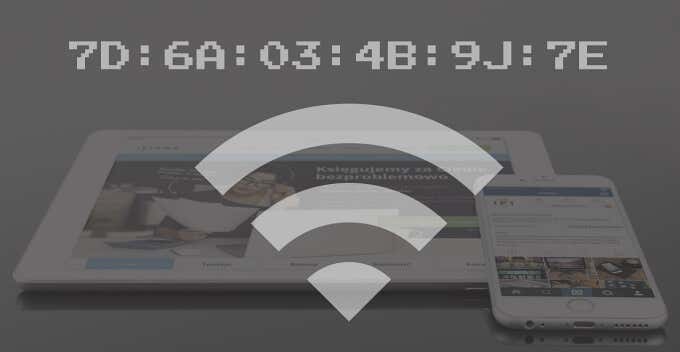Mobile operators use a unique 10-digit mobile identification number (MIN) to identify users and devices on the network. For wireless networks, the media access control (MAC) address is a unique metric used to identify the device and distinguish it from other users.
In a previously published post, I explained what a MAC address is and how to find a network identifier on your Mac and PC. This tutorial will focus on several ways to find the MAC address of your iPhone and iPad.

The MAC address consists of a combination of 12 hexadecimal alphanumerical characters grouped into pairs by columns. Some devices separate the characters in a pair with a hyphen or a dash (-), while others simply leave a space between the pairs.
There are many reasons why you need a MAC address for your iPhone or iPad. You can also track data usage on your home network. When you configure a quality of service (QoS) filter on your router, you always need the MAC address of the preferred device. Want to allow only specific devices on your network? The router may require the MAC address of the device.
Let’s take a look at some ways to find the MAC address of your iPhone and iPad.
1. Check the information menu on your iPhone or iPad
Open the Settings app and go to setting >> >> Universal >> >> about Scroll down to the network section of the page. The MAC address of the iPhone is Wi-Fi address Field.

2. Check the network settings menu
This setting is the easiest way to find out the MAC address of your iPhone or iPad. Wi-Fi settings for iOS or iPad OS setting >> >> WifiTap the active Wi-Fi network.

The MAC address of the iPhone is[Wi-Fiアドレス]It’s in the field.

Simple tip: To copy the MAC address of the device[Wi-Fiアドレス]Press and hold the field[[copy..

3. Check the router app
If your Wi-Fi router has an iOS-only app, you should be able to see your iPhone’s MAC address through the app. The steps to find your iPhone’s MAC address through your router app may vary depending on your router brand, model, app design, interface, and version.
Still, I’m sure you’ll find the information you need in the device management menu of your router’s app. Check the list of devices connected to your Wi-Fi router and select your iPhone. Go through the device information page to see the MAC address field (or a combination of 12 alphanumers).

Can’t find your iPhone in the list of connected devices? Disable Wi-Fi on your iPhone, rejoin the network and check again. Closing and reopening the app may resolve the issue. Finally, and most importantly, make sure your app is updated. Open the App Store, check for updates available on the App Store, and see if they do.
4. Display the MAC address from the smart home app
If you have linked your router to a smart home app, you should be able to see the MAC address of the device connected to your router. I use Huawei’s AI Life app to manage devices on my smart home network. The app has a “Device Information” section that shows the IP and MAC addresses of all the devices connected to your Wi-Fi router.

Connect your iPhone to your home network and check the smart home app settings or device management menu. If you haven’t joined the smart home train yet, check out some of the best apps for smart home automation.
5. Using a web browser
The Router Management Console gives you control over how your device interacts with your network. You can change the network configuration, disable Internet access, check the MAC address of the connected device, and so on.
Refer to your router’s instruction manual or contact the manufacturer for instructions on how to access the admin panel. You need to access a unique IP address in your web browser and enter your router’s administrator credentials (that is, your username and password).
After logging in, go to the WLAN Settings, Wi-Fi Settings, Wi-Fi Status, or Device Management menus to see the devices connected to your network. Find your iPhone in the list and check its MAC address.

Again, it is not possible to accurately list the steps to access the router’s administration panel. This is because the steps may vary depending on factors such as router brand, management panel gateway, and internet service provider.
Description of iOS private MAC address
The MAC address in the iPhone settings menu must match the MAC address of your router. This was the case until iOS 14 was introduced. Apple believes that using the same Mac address on multiple networks makes it much easier for Internet service providers (ISPs) and other stakeholders to track their location and monitor their activity over time. ..

To prevent this, Apple has introduced “private Wi-Fi addresses” on iOS 14, iPadOS 14, and watchOS 7. This feature is enabled by default on all devices running the aforementioned operating systems.
This iOS feature assigns a unique MAC address to every Wi-Fi network. That is, your iPhone or iPad has different MAC addresses such as Network A, Network B, and Network C.
It’s definitely a great concept with a focus on privacy. However, not all networks support devices that use private addresses. If you don’t have access to the Internet on your Wi-Fi network, we recommend disabling the private address on that network.
Move to settingselect WifiTap the affected network to switch it off Private address option.

Obsolete method: Third-party network apps
In the past, many iPhone and iPad users used network monitoring tools and Wi-Fi analyzer apps to verify the device’s MAC address. Things changed when Apple released iOS 11 and blocked third-party applications from reading MAC addresses.
Do you know other built-in techniques or third party tools for checking MAC address on iPhone or iPad? Please share with us in the comments below.